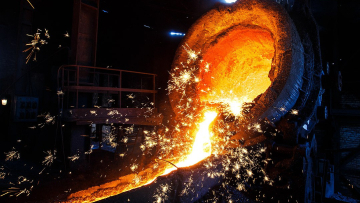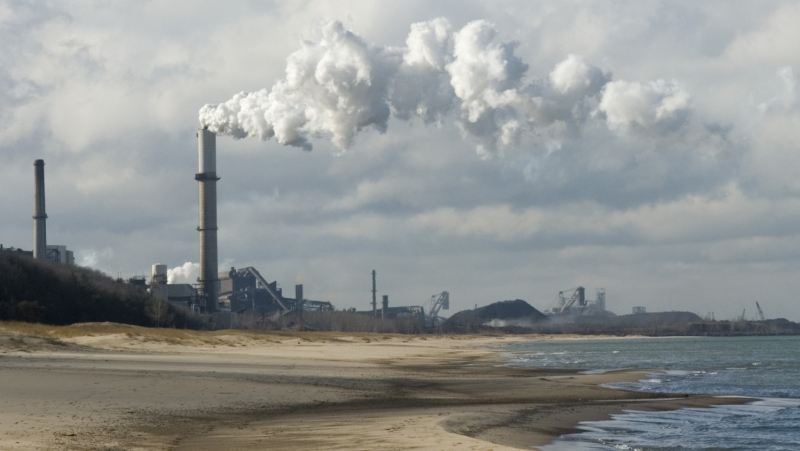
Project – Active
This profile is actively maintainedJulia Hovenier – BankTrack
Julia Hovenier, Banks and steel campaigner,
julia@banktrack.org

Project – Active
This profile is actively maintainedJulia Hovenier – BankTrack
Julia Hovenier, Banks and steel campaigner,
julia@banktrack.org
Why this profile?
Ohio-based steel producer Cleveland-Cliffs announced its plans to reline (i.e. extend the lifetime of) one of its coal-based steel making units in 2026 and another in 2027. This could keep the coal-based plant in operation until 2040, rather than replace it with fossil free technology. In order for the steel industry to achieve 1.5C alignment, prevent catastrophic warming, and mitigate harm to local communities, any blast furnaces that reach the end of their lifetimes must not be relined.
What must happen
Financiers of Cleveland-Cliffs must engage with their client and require it to switch the Burns Harbour plant to fossil-free technologies rather than extend the lifetime of its coal-based steel making facilities. The company should also publish a fully Paris-aligned transition plan for all of its steel-making assets and other activities. Future financing should be conditional upon the achievement of these objectives.
| Sectors | Iron and Steel Manufacturing |
| Location |
|
| Status |
Planning
Design
Agreement
Construction
Operation
Closure
Decommission
|
| Website | https://www.clevelandcliffs.com/operations/steelmaking/burns-harbor |
Burns Harbor Works Steel Mill is owned and operated by Cleveland-Cliffs, a major supplier of steel to the automotive industry in the United States. It produced 3.3 million tons of crude steel in 2021, but has the capacity to produce 5 million tons. The plant uses two blast furnaces to process coking coal, iron ore, and other raw materials brought in through the Port of Indiana.
In May 2023, Cleveland-Cliffs announced its plans to reline (i.e expand the lifetime of) one of its coal-consuming blast furnaces. The relining process will start in 2026, and could keep the coal-based blast furnace in operation until 2040. Cleveland-Cliffs has committed to reducing its emissions by 25% by 2030, but has no concrete plans to replace its coal-based steel facilities with fossil free production methods, such as Electric Arc Furnaces (EAFs) which recycle steel, or Direct Reduced Iron facilities (DRI) which can convert iron ore into iron using hydrogen made from renewable energy.
Impact on human rights and communities
Carcinogenic emissions and lead pollution Burns Harbors was named "largest source of industrial lead pollution" in the United states by the Chicago Tribune after its blast furnaces emitted nearly 18,000 pounds of lead and 173,000 pounds of cancer-causing benzene in 2016. Additionally in 2021, the plant was responsible for 11,046 tons of asthma-causing sulphur dioxide, making it the largest emitter in Indiana. Burns Harbor is also home to two coking plants, which process metallurgical coal into coke, which can be burned in a blast furnace. According to a peer-reviewed public health study conducted on a similarly sized steel plant also on Lake Michigan, closing a coking plant can reduce weekly emergency room visits for cardiovascular admissions by 42%.
Impact on climate
Colossal and unnecessary carbon emissions According to estimates derived from the US Environmental Protection Agency’s Greenhouse Gases data set, If just one blast furnace at Burns Harbor is relined, it would release an estimated 68 million tonnes of CO2e over its extended lifetime, equivalent to operating a coal plant every year for 18 years. In order to be in line with limiting global warming to 1.5C, blast furnaces that reach the end of their lifetimes in this decade must be transitioned to fossil free technologies.
False climate solutions In December 2022, Cleveland-Cliffs proposed a carbon capture and storage (CCS) project on one of its blast furnaces at the Burns Harbor plant. It is currently planning the pilot, with a planned completion date of end 2023. The goal of the pilot is to capture at least 95% of CO2 released from the blast furnace. However, there have been no successful CCS projects in steel making to date, and it has not proven successful in other fossil-fuel based sectors. Additionally, CCS does not address the methane released from coal mining, which would still be required if the blast furnace continues to be used. Therefore, instead of relining the coal-based production facilities at Burns Harbor in combination with currently unproven CCS technology, Cleveland-Cliffs should use the current opportunity to shift the plant to fossil free production technologies.
Impact on nature and environment
Acidification of Lake Michigan Due to a failure in the blast furnace water recycling system, in August 2019 Burns Harbor discharged millions of gallons of water containing cyanide and ammonia-nitrogen into the Little Calumet River and Lake Michigan. As a result, an estimated 3,000 fish died, beaches in the Indiana Dunes National Park were closed, and contaminated the drinking water of local communities. The Environmental Law and Policy Center found that Burns Harbor had violated the Clean Water Act over 100 times between 2015-2019.
The blast furnace reline at Burns Harbor will cost an estimated USD 300 millon. It is expected that the company will fund this through its own capital.
Cleveland-Cliffs currently has two main sources of debt financing:
1. On April 11th 2023, 12 banks underwrote a USD 750 million bond for Cleveland-Cliffs. The bond matured in April 2023;
2. On June 9th 2023, Cleveland-Cliffs refinanced their Asset Based Lending Facility, bringing its maximum borrowing base to a total of USD 4.75 billion, and extending the maturity date of the credit facility to June 9th 2028. The credit facility is led by Bank of America, for the other 18 lenders, see below.
